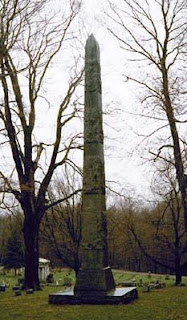 |
| Artist's depiction of the Ashtabula River Bridge disaster in 1876 |
At around 7:28 the train crossed the Ashtabula River Bridge as it neared the Ashtabula station, suddenly the bridge began to buckle and collapse under the weight of the locomotives and the full passenger cars. The entire train except for the first locomotive which had reached the other side, plunged 75 feet into the icy river below. Incredibly, most of the passengers and crew had survived the fall with the exception of a few.
 |
| Photo of the Ashtabula River Bridge before the collapse |
Things immediately got worse for the passengers, the stoves that kept them warm during the cold winter trip became their worst enemy as flames broke out among the passenger cars. Even though most passengers had survived the initial crash, they were trapped in the cars because they were sandwiched on top of one another in a pile of debris. The shiny wooden cars all covered in varnish, quickly became ablaze and the fire spread quickly. The broken oil lamps that had not already ignited added even more fuel to the fire. Those who managed to crawl out of the mayhem found themselves in the icy waters of the Ashabula River and within minutes succumbed to hypothermia and perished. In all, almost one hundred were died in the disaster including some who died from their injuries days later. Most of the dead were unrecognizable and could not be identified. They were taken to the nearby Chestnut Grove Cemetery and interred in a mass grave.
 |
| Photo of the Ashtabula River Bridge after the collapse |
 |
| Remains of the locomotive that plunged 75ft into the Ashtabula River after the bridge it was crossing collapsed |
Upon investigation of the accident it is said that the bridge was poorly constructed and contained flaws. Even after there were reports by workers on the bridge of strange popping and creaking noises, the bridge was allowed to remain open. After testifying at a trial, two of the men held partially responsible for the disaster ended up dead. Charles Collins was found with fatal gunshot would the day after he testified. Initially they thought he had committed suicide, however years later a forensic investigation of his remains would reveal that he was actually murdered as a result of his testimony. By whom, we may never know. The other individual held responsible, Amasa Stone, could not deal with the guilt of having killed all of those people and took his own life.
 |
| A monument in the Chestnut Grove Cemetery in Ashtabula, Ohio marks the mass grave of the unidentified victims of the Ashtabula Bridge disaster |
Over the years many visitors to the Ashtabula Bridge disaster site claim to be able to hear the screams and moans of people carrying on the wind. Many also say that they can faintly smell burning varnish in the air. The mass grave in Chestnut Grove Cemetery is today marked with a large monument that honors the unknown dead of the Ashtabula disaster. Some who have visited the site claim they have seen a few people gathering and strolling near the monument dressed in late 1800s attire as if they were attending a picnic or were attending a church social. When approached, these strange visitors would disappear. Many believe that these are the passengers of the Pacific Express who perished that fateful night back in 1876 and whose bodies lie in that spot unclaimed and unknown.
 |
| Site of the Ashtabula River Bridge disaster in Ashtabula, Ohio today |

No comments:
Post a Comment